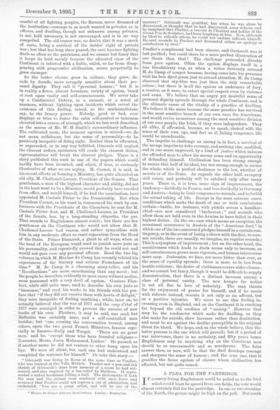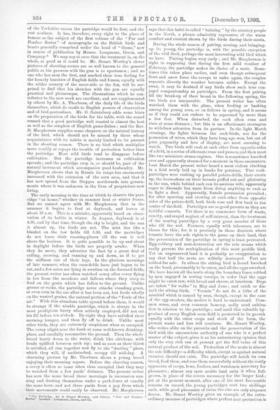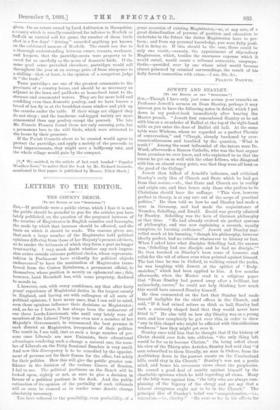A PLEA FOR THE PARTRIDGE.
IF country-living Englishmen could be polled as to the bird which could least be spared from our fields, the vote would almost certainly fall for the partridge. In one or two counties of the North, the grouse might be high on the poll. But south of the Yorkshire moors the partridge would be first, and the rest nowhere. It has, therefore, every right to the place of bonour as the subject of the first volume of the "Fur and Feather Series" of monographs on the British birds and beasts generally comprised under the head of "Game," now in course of publication by Messrs. Longmaias, Green, and Company.* We may say at once that the treatment is, on the whole, as good as it could be. Mr. Stuart Wortley's clever pictures of shooting-scenes are as well known to the general public as his prowess with the gun is to sportsmen ; and no one who has seen the first, and marked their true feeling for the homely beauties of English fields and fences, equally with the wilder scenery of the moor-side or the fen, will be sur- prised to find that his sketches with the pen are equally practical and picturesque. The illustrations which he con- tributes to the new work are excellent, and are supplemented by others by Mr. A. Thorburn, of the daily life of the birds themselves, which do credit to English powers of observation and of bird-portraiture. Mr. G. Saintsbury adds some hints on the preparation of the birds for the table, with the sound remark that a good partridge well roasted is almost the best as well as the simplest of English game-dishes ; and the Rev. H. Macpherson supplies some chapters on the natural history of the bird, which should not be missed by those whose acquaintance with its habits is mainly limited to its pursuit in the shooting season. There is no bird which multiplies more readily or repays the trouble of protection better than the partridge. Most wild birds tend to disappear before cultivation. But the partridge increases as cultivation spreads ; and the partridge crop is, or should be, part of the natural increment which accompanies good husbandry. Mr. Macpherson shows that in Russia its range has enormously increased with the extension of the corn area, and that it has now spread from the Steppes northwards into govern- ments where it was unknown in the lives of proprietors now living.
The early morning is the time at which to observe the part- ridge "at home," whether in summer heat or winter frosts. But we cannot agree with Mr. Macpherson that in the summer it begins to feed at daybreak, and leaves at about 10 a.m. This is a mistake, apparently based on obser- vation of its habits in winter. In August, daybreak is at 4.30, and by that time, though the sky is bright, and the sun is almost up, the birds are not. The mist lies like a blanket on the low fields till 5.30, and the partridges do not leave their roosting-places till the sun is well above the horizon. It is quite possible to be up and about in daylight before the birds are properly awake. When they do move, they advertise the fact by a great deal of calling, crowing, and running up and down, as if to get the stiffness out of their legs. In the glorious mornings of late summer, when the corn-fields have just begun to be out, and a few acres are lying in swathes on the forward fields, the present writer has often watched covey after covey flying in low from the meadows and fallows where they sleep to feed on the grain which has fallen to the ground. Unlike grouse or rooks, the partridge never attacks standing grain, or even corn in the ear after it has been cut, but feeds wholly on the wastrel grains, the natural portion of the "fowls of the air." With this abundant table spread before them, it would be strange if the nimble partridge, which is always in the most prodigious hurry when actively employed, did not eat his fill before ten o'clock. By eight they have satisfied their morning hunger, and then fly off to drink. Unlike most other birds, they are extremely suspicious when so occupied. The covey alight near the bank at some well-known drinking. place, and carefully reconnoitre the ground. Then the whole brood hurry down to the water, drink like chickens, with heads uplifted between each sip ; and as soon as their thirst is satisfied, all rise together and fly to the "dusting " place, which they will, if undisturbed, occupy till mid-day. A charming picture by Mr. Thorburn shows a young brood enjoying their morning repose. Before the shooting season, a covey is often so tame when thus occupied that they may be watched from a few yards' distance. The present writer has seen the same brood three mornings in succession sun- ning and dusting themselves under a park-fence at exactly the same hour, and not three yards from a gap from which their movements could easily be observed. Mr. Macpherson * Tho Partridge. By A. Stuart Wortley, and Others. "Fur and Feather Series." London Longmans, Green, and Co. says that this habit is called " balming " by the country people in the North, a phrase admirably expressive of the warm comfort and content shown by the birds during their siesta.
During the whole season of pairing, nesting, and bringing- up its young, the partridge is, with the possible exception of the wild duck, perhaps the most interesting wild bird which we have. Pairing begins very early ; and Mr. Macpherson is right in supposing that during the first mild weather of February, the partridge makes its Choice of a mate. Some- times this takes place earlier, and even though subsequent frost and snow force the coveys to unite again, the couples separate directly the weather becomes milder. Except the swan, it may be doubted if any birds show such true con- jugal companionship as partridges. From the first pairing till the break-up of their brood in the following spring, the two birds are inseparable. The present writer has often watched them with the glass, when feeding or basking among the young corn, or on fellows in spring, and it seems as if they could not endure to be separated by more than a few feet. When disturbed, the cock often rune and rises at some distance ; but this is an affectionate stratagem to withdraw attention from its partner. In the light March evenings, the fights between the cock-birds, not for the possession of wives, which they have long ago won, but out of pure pugnacity and love of display, are most amusing to watch. Two birds will rush at each other from opposite sides of a field, in a series of alternate runs and pauses, and then meet like two miniature steam-engines. One is sometimes knocked over and apparently stunned for a moment in these encounters. Last March the present writer heard a most violent clucking in a field newly laid up in banks for potatoes. Two cock. partridges were rushing up parallel potato-drills, their crests up, the horse-shoes on their breasts puffed out and glistening in the sun, while behind each ran its anxious wife, apparently eager to dissuade her mate from doing anything so rash as to fight a duel. Apparently, female persuasion prevailed ; for after spurring and crowing at each other from opposite sides of the potato-drill, both birds rose and flew back to the centre of the field. Partridges are as good parents as they are faithful consorts. Yet there is no commoner form of waste, cruelty, and stupid neglect of self-interest, than the treatment of the nesting partridges by a very great number of those who till the soil. Farmers, equally with labourers, are to blame for this ; for it is precisely in those districts where tenants have the sole rights to the game on their land, that the persecution of the partridge in spring is least prevented. Egg-robbery and nest-destruction are the sole means which really prevent the multiplication of this most prolific bird. Yet on unpreserved land it is probably no exaggeration to say that half the nests are wilfully destroyed. Part are robbed for sale. In others the sitting bird is found knocked on the head, presumably to be eaten, and all the eggs smashed. We have known all the nests along the boundary fence robbed by men engaged in sowing turnips, in order that the eggs might be eaten raw, with bread and cheese, at luncheon. Dogs are taken "for walks" in May and June ; and catch or dis- turb the sitting birds. " Vermin " do not do a tithe of the mischief which is caused by man, though, except in the case of the egg-stealers, the motive is bard to understand. Com- mon sense, and even common honesty, sadly need cultiva- tion in relation to the partridge ; and until this valuable by- product of every English corn-field is protected in its growth equally with the other crops and stock of the farm, the present waste and loss will continue. Mr. Stuart Wortley, who writes alike on the pursuits and the preservation of the bird with the unconscious authority of one who is a perfect master of the subject, gives it as his unhesitating opinion that only the very rich can at present get the full value of this natural product of the soil. Protection of the nests is almost the sole difficulty—a difficulty which, except as against natural enemies, should not exist. The partridge will hatch its own brood, feed them, and rear them successfully without the costly apparatus of coops, hens, feeders, and watchmen necessary for pheasants ; almost any open arable land suits it when full- grown, in place of the covers necessary for the larger bird ; yet at the present moment, after one of the most favourable seasons on record, the young partridges cost two shillings each, while good pheasants of twice the size are only sixpence dearer. Mr, Stuart Wortley gives an example of the extra- ordinary increase of partridges where perfect nest-protection is given. On an estate owned by Lord Ashburton in Hampshire, a county which is usually considered far inferior to Norfolk or Suffolk as natural soil for game, the number of these birds shot in a few days' " driving " exceeded anything yet known on the celebrated manors of Norfolk. The result was due to a thorough understanding between owner, tenants, workmen, and keepers, that the partridge-nests were property to be eared for as carefully as the nests of domestic birds. If the same good sense prevailed elsewhere, partridges would sell throughout the year at an average price of from ninepence to a shilling—that, at least, is the opinion of a competent judge in "the trade."
Tame partridges are one of the greatest ornaments to the precincts of a country house, and should be as necessary an adjunct to the lawn and paddocks as home-bred trout to the streams and ornamental waters. They are far more bold and -confiding even than domestic poultry, and we have known a brood of ten fly in at the breakfast-room window and pick up the crumbs under the table, If their wings are clipped they do not stray ; and the handsome red-legged variety are more ornamental than any poultry except the peacock. The late Mr. Francis Francis found them not only amusing pets, but a permanent lure to the wild birds, which were attracted to the house by their presence. If the Parish Councils about to be created would agree to protect the partridge, and apply a moiety of the proceeds to local improvements, they might save a halfpenny rate, and the whole village would gain by the compact.
[*** We omitted, in the article of last week headed " Popular 'Weather-Lore," to notice that the book by Mr. Richard Inwards, mentioned in that paper, is published by Messrs. Elliot Stock.]








































 Previous page
Previous page